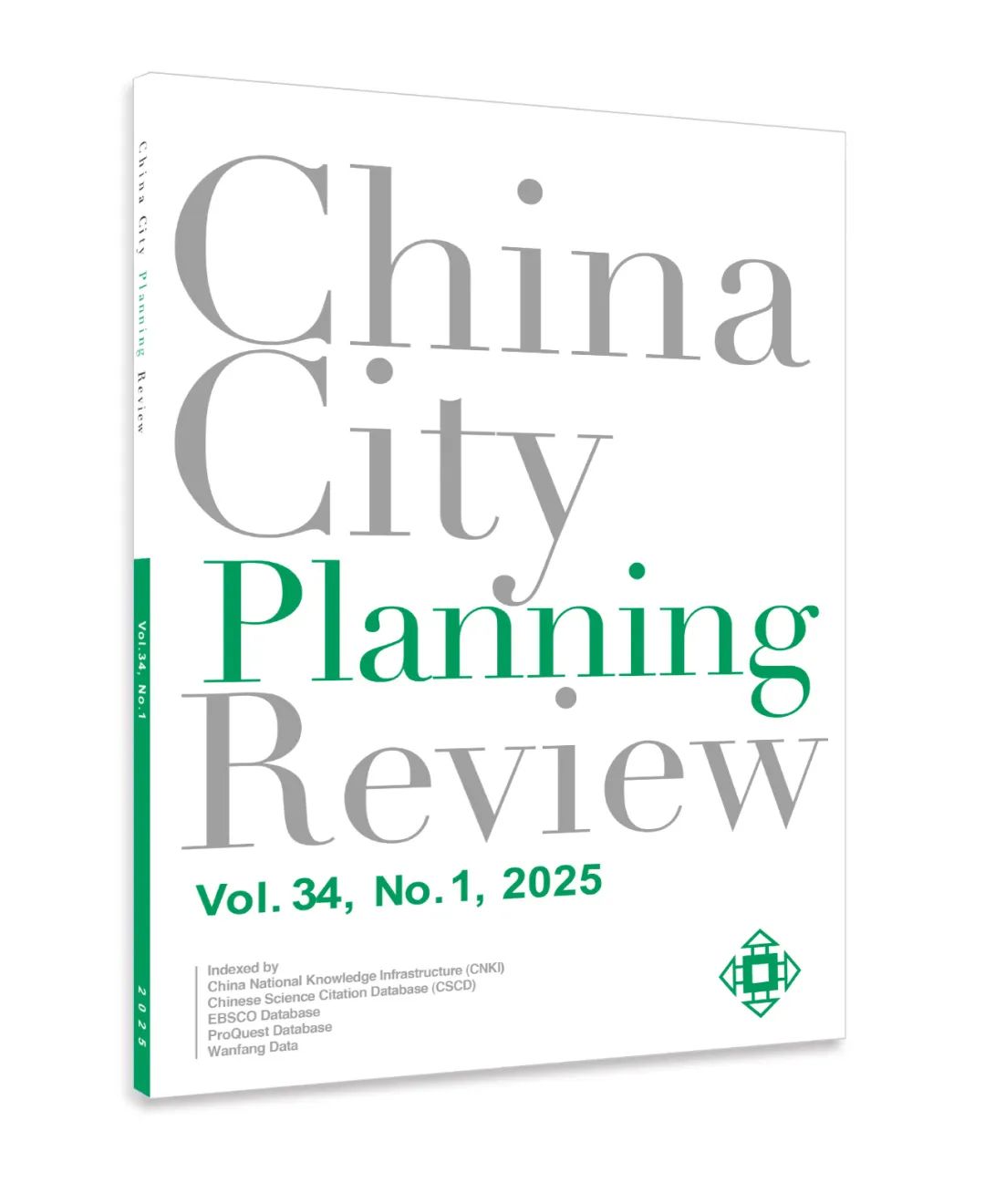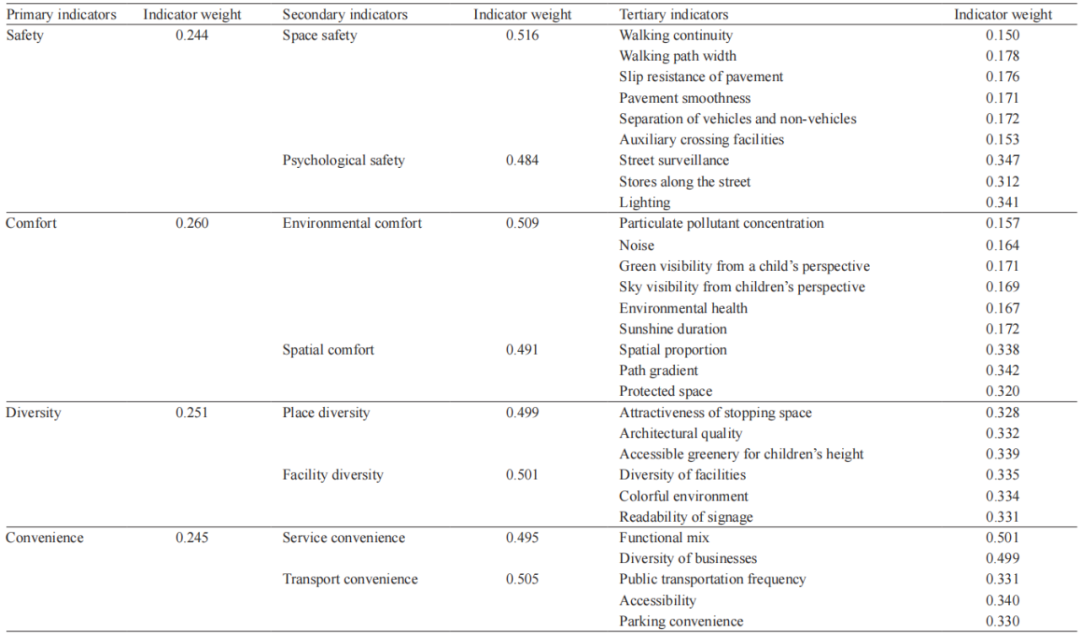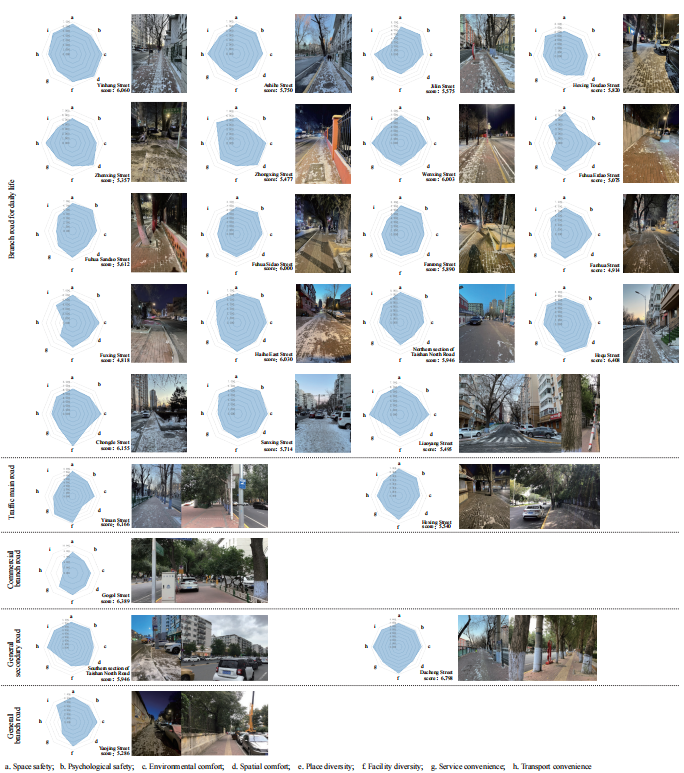✦ CSCD 核心库收录期刊
✦ CNKI 全文收录期刊
✦ ProQuest 收录期刊
✦ Wanfang 收录期刊
✦ SciOpen全文收录期刊
文章题目
儿童友好视角下寒地城市通学路径评测及优化策略研究——以哈尔滨市为例
Research on the Evaluation and Optimization Strategy of Children’s School Commuting Path in Cold Climate Cities from the Perspective of Child-Friendliness: Taking Harbin as an Example
作者
刘羿伯,孙澄 ‖ Liu Yibo, Sun Cheng
文章介绍
关注儿童权益与健康成长,对于实现社会经济持续协调健康发展至关重要。已有研究证实儿童友好型通学路径的建设对儿童健康成长、全面发展具有不可忽视的作用。如何提升儿童通学路径品质,营建儿童支持性环境,受到国内外研究机构和专家学者的重视。尽管已有研究涉及儿童机体特征与通学路径空间环境的联系,但以儿童作为诉求对象与策略应用对象的研究成果较少,且研究更多集中在欧美国家,缺乏可为我国设计实践提供量化分析和可靠指导的有效评测工具。此外,寒地城市作为较特殊的城市群体,特殊的气候条件和明显的季节性特征为儿童的身心健康以及空间环境质量带来了诸多挑战,但相关研究较为匮乏。基于上述背景,本文从儿童友好角度出发,结合寒地城市儿童特征与通学路径空间环境诉求,构建通学路径评测模型,并进一步将其应用于哈尔滨市的样本案例,以此为依据提出优化策略,旨在为寒地城市通学路径空间环境设计与既有环境更新提供决策依据与实践指导,进一步以儿童友好为目标提升寒地城市儿童健康水平。
本文研究区域集中在典型寒地城市哈尔滨市的中心区域南岗区(东经126°45′~126°43′,北纬45°30′~45°40′),城区面积 60 平方千米,常住人口139.1万人,教育事业领跑全市。研究通过对哈尔滨市南岗区16所学生人数超过2000人的热点小学进行走访调研。为了提高研究的准确性与覆盖度,基于个案研究的通学路径原则,本文选取继红小学南岗校区、哈尔滨师范附属小学、复华小学南岗校区、虹桥第一小学、铁岭小学校(大成校区)5个小学作为典型案例,参照《城市居住区规划设计标准(2018)》小学布局的服务半径,同时考虑到小学生步行速度、距离有限,将适宜的步行距离作为前提,共识别出25条通学路径进行分析。
通学路径是儿童接触社会和自然的重要公共空间。寒地城市通学路径在生理需求、心理需求和行为需求方面分别有以下特殊性:(1)寒地城市通学路径设计时除了要考虑儿童对于障碍物的感知范围较成年人小所造成安全隐患,还要考虑寒地城市儿童身体尺度的适应性。此外,通学路径儿童高度处的空气质量及路面防护更需要被关注。(2)需调动听觉、嗅觉、触觉等方式,积极利用冬季冰雪元素,为儿童提供具有探索意义的空间环境,应对季节性心理变化。(3)充分考虑活动空间的安全性、丰富性以及容纳性,尤其是冬季活动的防护以及充足的日照。
文章基于文献研究和寒地城市通学路径需求提取了寒地城市通学路径评测指标,结合儿童友好视角与寒地城市特征,共选取4个维度的二级评测指标8项、三级评测指标29项,从安全性、舒适性、多样性、便捷性四个方面对寒地城市通学路径建立评测体系。基于对评测指标的筛选进行评测模型的构建,以儿童视角、问卷调研和偏最小二乘结构方程模型进行了量表开发从而构建出测评模型,运用pls计算、Bootstrap计算和指标权重计算形成完整的测评体系。对样本小学通学路径的评测采用多种数据分析方法对各维度评测指标进行量化测度,评测指标的量化测度是以儿童身高为视点,通过机器学习、空间句法、现场调研等方法进行数据收集与处理,数据收集时间分别为2022年9月(非寒冷季节)、11月(寒冷季节)同一个星期内的工作日。其中,儿童视角的绿视率和天空可见率利用街景图像进行语义分割,对分割得到的环境要素比例进行统计分析;路径可达性采用空间句法中的整合度(Integration)进行衡量;其他指标数据多通过现场实测得到。指标测度完成后将测度结果进行归一化处理,利用层层加权求和测算通学路径各维度得分及综合得分,更精准识别通学路径的问题所在。
通过对25条通学路径的实地调研及每条通学路径特征画像的评测结果表明:在生活型支路、交通型主干路、商业型次干路、综合型次干道和综合型支路中通学路径的儿童友好度普遍得分处于中等水平,寒地城市通学路径的精细化水平较低,儿童友好要素可供性不足,而且季节性应对不足,对冬季防护考虑不周,同时,对空气、声音、绿化环境的儿童友好不够重视,健康安全风险较高。依据样本通学路径的类型及评测结果针对以下不同类型道路的通学路径提出优化策略。生活型支路应提高精细化水平,塑造鲜明情感倾向色彩和易识别的要素,增加临时避寒功能空间及儿童游憩设施。交通型主干道应强化舒适性考虑,丰富空间层次并划分空间,增设鲜明的标识和易识别的交通诱导系统,利用AI交互技术打造智慧通学路径。商业型次干道应提高便捷性,关注步行需求,强化儿童与界面的互动并满足儿童行为安全需求。综合型次干道应增加为儿童提供停留的公共空间节点,考虑不同季节的日照条件,发挥冬季冰雪资源优势。综合型支路应挖掘儿童可利用的小尺度活动空间,塑造儿童“非正式”活动场地,考虑多重功能复合化,丰富设施配置并重点考虑冬季使用需求。
Focusing on children's rights and healthy development is critical to achieving sustainable, coordinated, and healthy socio-economic development. Existing studies have proven that the construction of child-friendly school commuting paths plays an indispensable role in children's healthy growth and overall development. How to improve the quality of these paths and create supportive environments for children has attracted attention from research institutions and academic fields all over the world. Apart from the studies exploring the connection between children's physical characteristics and the spatial environment of school commuting paths, studies with children as the main stakeholders and targets for strategic application are relatively scarce. Furthermore, such studies are mostly concentrated in Europe and North America, with limited availability of evaluation tools that could provide effective quantitative analysis and reliable guidance for similar designs in China. Additionally, cold-climate cities face unique challenges due to their special climatic conditions and pronounced seasonal characteristics, which affect children's physical and mental health and the quality of spatial environments, yet relevant studies are still lacking. Based on this background, this paper adopts a child-friendly perspective, combining the specific characteristics of children in cold-climate cities with consideration to their demands for the spatial environment of school commuting paths. It constructs an evaluation model for school commuting paths and applies it to sample cases in Harbin City. Based on this evaluation, the study proposes optimization strategies to provide decision-making support and practical guidance for the design and upgrading of school commuting paths in cold-climate cities. The ultimate goal is to improve children's health levels in cold-climate cities by creating more child-friendly environments.
The study area is focused on the central district of Harbin, a typical cold-climate city in China, specifically Nangang District (located at 126°45′E to 126°43′E longitude and 45°30′N to 45°40′N latitude). The district covers an area of 60 km2 and has a permanent population of 1.391 million, with a leading position in the city's education sector. This study conducted field surveys in 16 elementary schools in Nangang District, each with more than 2,000 students. To ensure the accuracy and comprehensiveness of the study, the selection of school commuting paths for case studies followed 4 principles. Based on the principles, five schools were chosen for case studies, which are Jihong Elementary School Nangang Campus, Harbin Normal University Affiliated Elementary School, Fuhua Elementary School Nangang Campus, Hongqiao First Elementary School, and Tieling Elementary School Dacheng Campus. These schools were selected according to the service radius for school layouts specified in the Urban Residential Area Planning and Design Standards (2018). At the same time, considering the walking speed and distance restrictions for elementary school students, suitable walking distances were used as a premise, as a result, a total of 25 school commuting paths were identified
The concept of school commuting paths are an important public space for children to engage with society and nature. Such paths in cold cities have the following particularities in physiological needs, psychological needs and behavioral needs: (1) When designing school commuting paths in cold-climate cities, it is essential to consider not only children's limited perception range compared to adults, which may pose safety risks, but also the adaptability of the design to the physical scale of children in these cities. Additionally, pay special attention to air quality and road surface protection at the height level of children along commuting paths. (2) It is necessary to engage children’s senses including auditory, olfactory, and tactile stimuli, while actively incorporating winter elements like ice and snow to create spaces that are exploratory and engaging so as to help address seasonal psychological changes and enriches the commuting path environment for children. (3) It is essential to consider the safety, richness, and inclusiveness of the available activity spaces. Besides, in cold-climate cities, it is also necessary to consider winter activity protections and ensure adequate sunlight, particularly given the seasonal constraints.
Based on literature research and the demand for educational paths in cold cities, this article extracts evaluation indicators for educational paths in cold cities, and integrates a child-friendly perspective and the characteristics of cold climate cities. A total of 8 secondary indicators and 29 tertiary indicators across four dimensions were selected. An evaluation system for school commuting paths in such cities is established from four aspects: safety, comfort, diversity, and convenience. Based on the evaluation model of evaluation indicators, an evaluation model was constructed by developing scales from the perspective of children, questionnaire surveys, and partial least squares structural equation models. A complete evaluation system was formed using PLS calculation, Bootstrap calculation, and indicator weight calculation.This study quantified each evaluation indicator's measurement in the dimensions of elementary school commuting paths through multiple data analysis methods, including machine learning, space syntax, and field surveys, using children’s height as the viewpoint height. Data collection occurred during the same weekdays in September (non-cold season) and November (cold season) of 2022. Green visibility and sky visibility from children’s perspectives were evaluated using street view images, with semantic segmentation applied to identify environmental elements. The proportions of each identified element were then statistically analyzed. Path accessibility was measured using the integration value from space syntax, quantifying how accessible a path is within the overall urban network. Other indicators were mainly measured through on-site investigations. After completion, the measurement results were normalized. The weighted sum of scores for each dimension and the overall score for the school commuting paths were calculated to more accurately identify any issues in the commuting paths.
Through field research on 25 educational paths and the evaluation of the characteristic profiles of each path, it is shown that the child friendliness score of the educational paths in branch roads for daily life, traffic main roads, commercial branch roads, general secondary roads, and general branch roads typically ranges at a moderate level. School commuting paths in cold climate cities display a low level of refinement. The availability of child-friendly elements is insufficient, seasonal adaptations are lacking, and winter protection measures are poorly considered. Furthermore, factors such as air quality, noise, and green space are not adequately prioritized for children’s well-being, leading to increased health and safety risks.Based on the types of sample paths and their evaluation results, optimization strategies are proposed for the communication paths of the following different types of roads. Branch roads for daily life should focus on improving the level of refinement, shape distinctive emotional tendencies and easily recognizable elements, increase temporary cold shelter functional spaces, and provide children's recreational facilities. Traffic main roads should focus on improving the level of comfort, enrich spatial levels and divide spaces, add distinctive signs and easily recognizable traffic guidance systems, and use AI interactive technology to create intelligent communication paths. Commercial branch roads should focus on improving the level of convenience, pay attention to walking needs, strengthen interaction between children and interfaces, and meet children's behavioral safety needs. General secondary roads should provide children with areas to stop and rest, consider seasonal sunlight conditions, and leverage the potential of snow and ice resources. General branch roads should excavate small-scale activity spaces that children can use, shape informal activity areas for children, consider multi-functional spaces, enrich facility configurations, and focus on winter usage needs.
关键词
儿童友好,寒地城市,通学路径,评测,优化策略
child-friendly; cold climate cities; children’s school commuting path; evaluation; optimization strategy
主要图表

图1 评测体系构建流程图
Figure 1 Construction process of the evaluation system
表1 寒地城市通学路径评测体系表
Table 1 Evaluation system for commuting path in cold climate cities

表3 部分评测指标计算公式
Table 3 Calculation formulas used in the evaluation


图2 通学路径特征画像
Figure 2 Characteristic profile of commuting paths
作者简介
刘羿伯, 哈尔滨工业大学建筑学院/寒地城乡人居环境科学与技术工业和信息化部重点实验室,副教授。电子邮件:liuyibo9871@163.com
Liu Yibo, Associate Professor, Master’s Supervisor, School of Architecture and Design, Harbin Institute of Technology; Key Laboratory of National Territory Spatial Planning and Ecological Restoration in Cold Regions, Ministry of Natural Resources, Harbin, P. R. China. Email: liuyibo9871@163.com
孙澄, 哈尔滨工业大学建筑学院/寒地城乡人居环境科学与技术工业和信息化部重点实验室,国家级人才计划特聘教授,博导。电子邮件:suncheng@hit.edu.cn
Sun Cheng, National Talent Program Distinguished Professor, Doctoral Supervisor, School of Architecture and Design, Harbin Institute of Technology; Key Laboratory of Cold Region Urban and Rural Human Settlement Environment Science and Technology, Ministry of Industry and Information Technology, Harbin, P. R. China. Email: suncheng@hit.edu.cn
全文链接
http://www.ccprjournal.com.cn/news/10359.htm
欢迎您通过以下方式查询购买:
To purchase the new issue of CCPR, please contact us via:
Tel:010-82819550, Email:ccpr@planning.org.cn.
您也可以登陆我们的网站进行全文浏览:
Or you can also read the papers via:
www.ccprjournal.com.cn
《城市规划(英文版)》
China City Planning Review
网站/Website:www.ccprjournal.com.cn邮箱/Email:ccpr@planning.org.cn
微博/Weibo:城市规划英文版
微信/Wechat:ccpr_1985
电话/Tel:+86-10-82819550
投稿入口:https://csgy.cbpt.cnki.net/
转载本文请联系原作者获取授权,同时请注明本文来自SciOpen TUP科学网博客。
链接地址:https://wap.sciencenet.cn/blog-3563286-1497802.html?mobile=1
收藏

